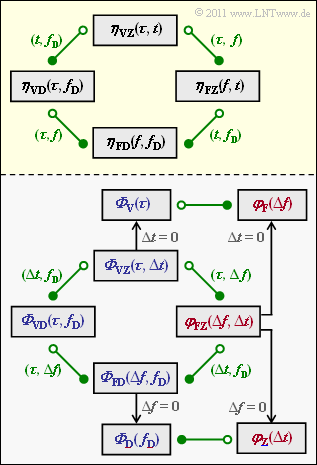Exercise 2.6: Dimensions in GWSSUS
The mobile radio channel can be described in very general terms by four system functions, whereby the relationship between each pair of functions is described by
- the Fourier transform or
- the inverse Fourier transform.
We denote all of the functions with ηi1i2. The indices i1 and i2 are defined as follows:
- V stands for delay τ (index i1),
- F stands for frequency f (index i1),
- Z stands for the time t (index i2)
- D stands for the Doppler frequency fD (index i2).
The relationship between the functions is shown in the diagram (yellow background). The Fourier correspondences are shown in green:
- The transition from a circle filled with white to a circle filled with green corresponds to a Fourier transform.
- The transition from a circle filled with green to a circle filled with white corresponds to the Fourier inverse transformation (opposite direction).
For example:
- ηVZ(τ,t)τ,f∘−−−∙ηFZ(f,t),ηFZ(f,t)f,τ∙−−−∘ηVZ(τ,t).
- The correlation function φ12 and the power density spectrum Φ12 are provided with the same indices as the system function η12.
- Correlation functions can be recognized by the red font in the lower graph and all power density spectra are labeled in blue. The GWSSUS–model is always assumed.
Let us consider here the system function ηVZ(τ,t), i.e. the time variant impulse response h(τ,t). The following descriptive variables result for these:
φVZ(τ1,t1,τ2,t2)=E[ηVZ(τ1,t1)⋅η⋆VZ(τ2,t2)],
Δτ=τ2−τ1,Δt=t2−t1⇒φVZ(δτ,δt),
φVZ(δτ,δt)=δ(δτ)⋅ΦVZ(τ,δt).
ϕV(τ)=ϕVZ(τ,δt=0).
Note: This task belongs to the chapter Das GWSUS–Kanalmodell.
Questionnaire
Sample solution
- ηVZ(τ,t) is the time variant impulse response, for which the term h(τ,t) is also common. Like every impulse response, h(τ,t) has the unit [1/s].
- By Fourier transformation of the function ηVZ(τ,t) with respect to the delay τ one obtains
ηFZ(f,t)=∫+∞−∞ηVZ(τ,t)⋅e−j⋅2πfτdτ.
- By the integration after τ (unit: s), ηFZ(f,t), also called „time-variant transfer function” is without unit. In some literature, H(f,t) is also used instead of ηFZ(f,t).
- The delay–Doppler–representation ηVD(τ,fD) also has no unit. This function results from the time variant impulse response ηVZ(τ,t) by the Fourier transformation with respect to t:
ηVD(τ,fD)=∫+∞−∞ηVZ(τ,t)⋅e−j⋅2πfDtdt.
- The function ηFD(t,fD) results from the dimensional functions ηVD(τ,fD) and ηFZ(f,t) respectively by a Fourier transformation, which results in the unit [s]=[1/Hz].
(2) Correct are the solutions 2 and 3:
- The autocorrelation function is by definition the following expected value:
φVZ(τ1,t1,τ2,t2)=E[ηVZ(τ1,t1)⋅η⋆VZ(τ2,t2)].
- Since the time variant impulse response ηVZ(τ,t) has the unit [1/s], its AKF φVZ has the unit [1/s2], both with the argument (τ1,l1,τ2,t2) and with the GWSSUS– argument (δτ, δt).
- The Dirac function δ(δτ) has the dimension [1/s], since the integral over all τ (with unit [s]) must result in the value 1. From this follows for the delay–time–cross power density ΦVZ(τ,δτ) the unit [1/s], as well as for the delay–power density ΦV(τ)=ΦVZ(τ,δt=0).
(3) Correct here are the statements 1 and 3:
- Starting from the unit [1/s] of the function ΦVZ(τ,δt) one arrives at τ or Δt to the functions φFZ(Δf,Δt) or ΦVD(τ,fD). Both are dimensionless.
- The frequency–Doppler–cross power density spectrum has the unit [s]=[1/Hz], because
ΦFD(δf,fD)=∫+∞−∞ΦVD(τ,fD)⋅e−j⋅2πfDτdτ.
